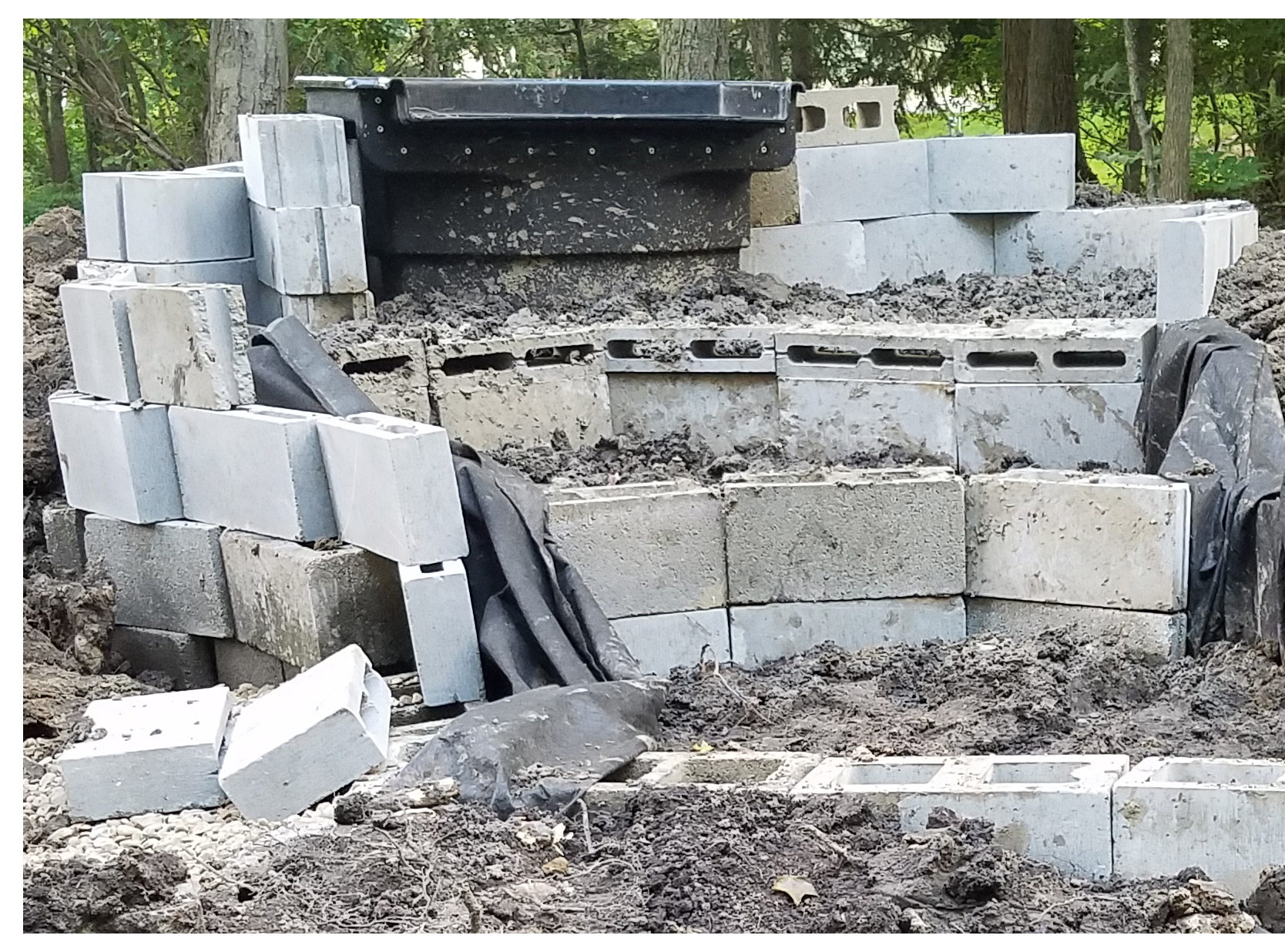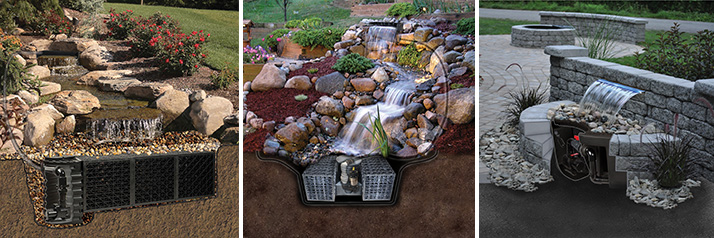How to Build a Pondless Waterfall
Pondless Waterfalls - How to Avoid Future Problems with your Water Feature:
I cannot express enough how many headaches and how much money you will save if your water feature is built with the future in mind. Using the proper waterfall supplies is an important factor in how well your water feature will maintain over years to come.
A Pondless Waterfall is simply a re-circulating waterfall, or stream, without the presence of open water.
Pondless water features work by pumping water contained in a large in-ground reservoir, or basin, up through the spillway. This allows water to flow back down into the reservoir - that is typically covered with gravel. Small areas of shallow water (a bog) can be created for aquatic plants to filter water and be a resource for birds and other wildlife to enjoy.
PONDLESS WATERFALL SUPPLIES:
Pumps - Choosing the correct pump can be a challenge..
- Most pondless waterfalls do not have enough elevation change or size to warrant a direct drive pump.
- Many of the direct drive pumps used in this application burn out within one to two years and are out of warranty.
- Asynchronous pumps generally produce all the water flow that we need for less money, both in initial cost and in electrical cost, plus they generally have a much longer warranty.
A Pump Vault should be buried in the reservoir in order to house the pump that is sized for your water feature.
- Your submersible pump should have plenty of room around it.
- This will allow easy access for maintenance, cleaning and repairs.
- Using a home-made pump vault (for example; like using a section of a drainage pipe) that is too small for the correct pump leads to problems and will cost you more time and money in the long run… Having a smaller space for the pump may cause you to use a direct drive pump instead of an asynchronous pump.
- Your pump vault should be made of a sturdy material that will not collapse under the pressure of the stone weight or freezing and thawing of water in the winter.
- Make sure the pump vault is set lower than the rest of the basin so water flows to it. This also makes it easier to clean the basin out once a year.

Eco-Blox or Res-Cubes will displace stone and gravel used in your reservoir. A cubic foot of gravel holds approximately 3 gallons of water. A cubic foot of Eco-Blox holds approximately 7.3 gallons of water.
- This allows for more water volume to ensure your pump stays submerged and that there is enough water to fill the stream without the basin running out of water.
- Using eco-blox or res-cubes also reduces the amount of gravel needed for your water feature project..
Gravel fills the reservoir, covering your vault and Eco-Blox, creating the “pondless” or “pond-free” appearance.
- Be sure that your pump vault does not get filled with gravel. This is important for the life of your pump.
- Rinsing the gravel thoroughly before you add to your feature will save a lot of trouble down the road. ***
- Dirt and sand will settle between the rocks in the reservoir, compacting and almost hardening like concrete.
- Over time, it will clog up the stone and not let the water back to the pump quick enough to operate your feature properly. This can result in burning up the pump and/or running the water right over the edges of the liner.
- Dirt and debris left in the gravel will also lead to more algae in your water feature.
- Use a bucket with holes, a basket or crate - like a colander, to rinse and re-rinse the gravel. The more dirt and sand removed ahead of time, the better!
- We have also rinsed gravel in a wheelbarrow, just be sure to agitate the gravel to get all of the dirt and sand out.
FastFalls is the box (diffuser) where your waterfall starts. It is easy to hide under stone to save space for more of the water feature.

- Since we are not building an eco-system in this instance, there is no need for an added biological filter (like those installed in a pond).
- A Fastfalls is a weir (spillway) built specifically to connect to your hose to spread water out for a more natural looking waterfall and to soften the flow of the water.
- Running just a hose to the top makes it difficult to control where the water goes.
- Most times, water comes out of a pipe with directed force, like a fire hose. The pressure will move stone around and make it difficult to spread out the water for your feature.
- We also know that water takes the path of least resistance. A Fastfalls will aim your water to the front of the pondless feature, reducing the risk of leaks as well as keeping the water out in front of the rocks.
- Easy Pro Black Waterfall Foam will fill voids behind and under rocks to also help re-direct water flow and keep it visible for more appeal.
- Fastfalls or Water Diffusers come in various lengths for small to large waterfalls and can even be linked together to create larger waterfalls.
- To get the proper flow of water, please read “ How to Choose the Perfect Pump for the Perfect Waterfall Blog.”
Pondless Waterfall Kits are available online ( click here) and at Hoffman’s Water X Scapes. This takes most of the figuring out of the equation because the components are there for you all in one box.

- Some Waterfall Kits include a basin, instead of a liner and pump vault. Basins store the water and protects the pump. The liner and underlayment included is for creating your waterfall / stream feature.
- Be sure that the basin and liner provided is large enough for the waterfall you envision.
- Laying the liner flat on the sides or under the spillway will definitely allow water to escape.
- You may need to purchase a separate piece of liner to accommodate your needs.
- The pond crew at Hoffman’s Water X Scapes is always here to help you calculate your products needed.
Level Ground - Building your pondless waterfall and/or stream on level ground is very important.
- Using the dirt dug out from the basin to build the waterfall/stream is fine, but remember it will settle.
- To stop the edges from sinking, creating a leak, we use cement blocks to form a wall along the edges and to create fall points inside the stream.
- Use soil from the basin inside and outside the walls, then compact the soil inside the stream.
- Cover the blocks with 2 layers of underlayment, then liner and then cover with stone and gravel to create a beautiful, durable stream and waterfall.

Now that you are armed with the knowledge of what to watch out for when building a pondless waterfall, we hope that you have a successful installation and that your new water feature brings you peace of mind.
